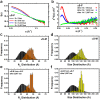Structural basis for the dissociation of α-synuclein fibrils triggered by pressure perturbation of the hydrophobic core
- PMID: 27901101
- PMCID: PMC5128797
- DOI: 10.1038/srep37990
Structural basis for the dissociation of α-synuclein fibrils triggered by pressure perturbation of the hydrophobic core
Abstract
Parkinson's disease is a neurological disease in which aggregated forms of the α-synuclein (α-syn) protein are found. We used high hydrostatic pressure (HHP) coupled with NMR spectroscopy to study the dissociation of α-syn fibril into monomers and evaluate their structural and dynamic properties. Different dynamic properties in the non-amyloid-β component (NAC), which constitutes the Greek-key hydrophobic core, and in the acidic C-terminal region of the protein were identified by HHP NMR spectroscopy. In addition, solid-state NMR revealed subtle differences in the HHP-disturbed fibril core, providing clues to how these species contribute to seeding α-syn aggregation. These findings show how pressure can populate so far undetected α-syn species, and they lay out a roadmap for fibril dissociation via pathways not previously observed using other approaches. Pressure perturbs the cavity-prone hydrophobic core of the fibrils by pushing water inward, thereby inducing the dissociation into monomers. Our study offers the molecular details of how hydrophobic interaction and the formation of water-excluded cavities jointly contribute to the assembly and stabilization of the fibrils. Understanding the molecular forces behind the formation of pathogenic fibrils uncovered by pressure perturbation will aid in the development of new therapeutics against Parkinson's disease.
Figures








Similar articles
-
Dissociation of amyloid fibrils of alpha-synuclein and transthyretin by pressure reveals their reversible nature and the formation of water-excluded cavities.Proc Natl Acad Sci U S A. 2003 Aug 19;100(17):9831-6. doi: 10.1073/pnas.1734009100. Epub 2003 Aug 4. Proc Natl Acad Sci U S A. 2003. PMID: 12900507 Free PMC article.
-
Complexation of NAC-Derived Peptide Ligands with the C-Terminus of α-Synuclein Accelerates Its Aggregation.Biochemistry. 2018 Feb 6;57(5):791-804. doi: 10.1021/acs.biochem.7b01090. Epub 2018 Jan 22. Biochemistry. 2018. PMID: 29286644
-
Biasing the native α-synuclein conformational ensemble towards compact states abolishes aggregation and neurotoxicity.Redox Biol. 2019 Apr;22:101135. doi: 10.1016/j.redox.2019.101135. Epub 2019 Feb 5. Redox Biol. 2019. PMID: 30769283 Free PMC article.
-
Pressure-temperature folding landscape in proteins involved in neurodegenerative diseases and cancer.Biophys Chem. 2013 Dec 15;183:9-18. doi: 10.1016/j.bpc.2013.06.002. Epub 2013 Jun 14. Biophys Chem. 2013. PMID: 23849959 Review.
-
α-synuclein aggregation and its modulation.Int J Biol Macromol. 2017 Jul;100:37-54. doi: 10.1016/j.ijbiomac.2016.10.021. Epub 2016 Oct 11. Int J Biol Macromol. 2017. PMID: 27737778 Review.
Cited by
-
High-Pressure-Driven Reversible Dissociation of α-Synuclein Fibrils Reveals Structural Hierarchy.Biophys J. 2017 Oct 17;113(8):1685-1696. doi: 10.1016/j.bpj.2017.08.042. Biophys J. 2017. PMID: 29045863 Free PMC article.
-
The effects of biological crowders on fibrillization, structure, diffusion, and conformational dynamics of α-synuclein.Protein Sci. 2024 Mar;33(3):e4894. doi: 10.1002/pro.4894. Protein Sci. 2024. PMID: 38358134 Free PMC article.
-
High-Pressure Response of Amyloid Folds.Viruses. 2019 Feb 28;11(3):202. doi: 10.3390/v11030202. Viruses. 2019. PMID: 30823361 Free PMC article. Review.
-
Isoelectric point-amyloid formation of α-synuclein extends the generality of the solubility and supersaturation-limited mechanism.Curr Res Struct Biol. 2020 Apr 5;2:35-44. doi: 10.1016/j.crstbi.2020.03.001. eCollection 2020. Curr Res Struct Biol. 2020. PMID: 34235468 Free PMC article.
-
A Protofilament-Protofilament Interface in the Structure of Mouse α-Synuclein Fibrils.Biophys J. 2018 Jun 19;114(12):2811-2819. doi: 10.1016/j.bpj.2018.05.011. Biophys J. 2018. PMID: 29925018 Free PMC article.
References
-
- Spillantini M. G. et al.. Alpha-synuclein in Lewy bodies. Nature 388, 839–840 (1997). - PubMed
-
- Polymeropoulos M. H. et al.. Mutation in the alpha-synuclein gene identified in families with Parkinson’s disease. Science 276, 2045–2047 (1997). - PubMed
-
- Krüger R. et al.. Ala30Pro mutation in the gene encoding alpha-synuclein in Parkinson’s disease. Nat. Genet. 18, 106–108 (1998). - PubMed
-
- Singleton A. B. et al.. alpha-Synuclein locus triplication causes Parkinson’s disease. Science 302, 841 (2003). - PubMed
-
- Chartier-Harlin M. C. et al.. Alpha-synuclein locus duplication as a cause of familial Parkinson’s disease. Lancet 364, 1167–1169 (2004). - PubMed
Publication types
MeSH terms
Substances
LinkOut - more resources
Full Text Sources
Other Literature Sources
Miscellaneous

